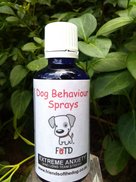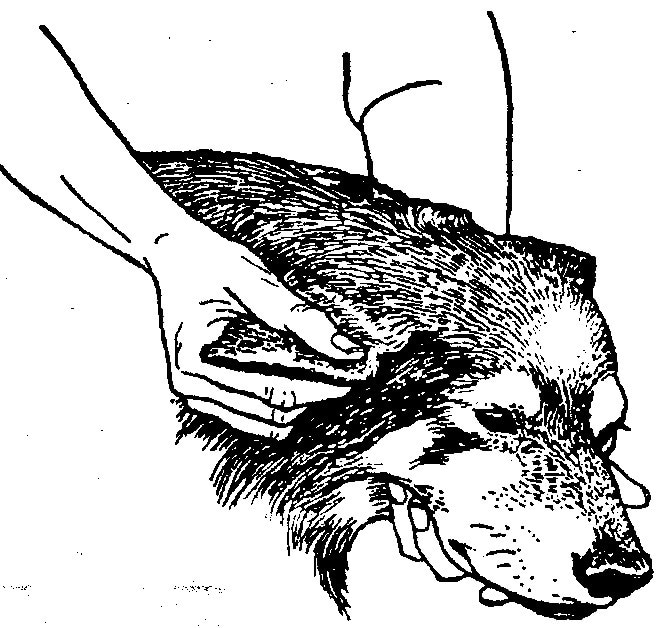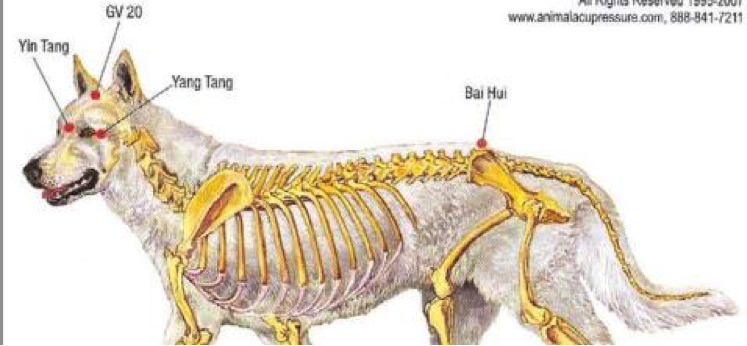FOTD BEHAVIOUR SPRAY - EXTREME ANXIETY - SUGGESTED BEHAVIOUR MODIFICATIONS
In addition to spraying the dog (as suggested and directed) twice a day, apply the spray to the bedding and in any situation the dog may feel stressed.
Basic behaviour modifications will help the dog to cope and here are some suggestions below and please do not hesitate to get your dog professional help if it needs it. You are welcome to contact me at [email protected] and if you are not in my area, I will recommend you to a behaviourist that is.
Here are some general modifications to bring into use:
Basic TTouches to relax your dog. It is my belief that if each and every owner learned the basics of TTouch our animals world would be a much better place!
Until you learn how to do TTouch (and Scotty does offer lessons), here is an Ear Touch you can use as well as some basic Acupressure stroking techniques - both of which, especially when done daily, will help to reduce your dogs stress levels. Although you are not doing actual Acupressure, just stroking in these areas with your fingers - using a gentle pressure, will help to reduce anxiety.
Basic behaviour modifications will help the dog to cope and here are some suggestions below and please do not hesitate to get your dog professional help if it needs it. You are welcome to contact me at [email protected] and if you are not in my area, I will recommend you to a behaviourist that is.
Here are some general modifications to bring into use:
- Identify the stress factors and avoid these as much as possible or at least reduce exposure. E.g. if your dog does not cope with other dogs, don’t go to a park with other dogs or walk your dog in the street – rather walk your dog in an area such as the parking lot of a shopping centre where you are not likely to meet other dogs. Never walk a dog that has issues with other dogs in the street – this is just aggression waiting to happen when the dog is exposed to other barking and lunging dogs behind gates.
- Do not pander to the dog’s stress. Dogs are not the same as humans – if we see somebody who is stressed or not coping, our first instinct is to comfort the person. This acts in exactly the opposite manner with dogs – the more we pay attention to the dog when stressed, the more the dog tends to think that there is something to be stressed about! If your dog is stressing you can either ‘just be around’ but not molly coddling or comfort by way of cuddling, picking up and similar; divert the dogs attention onto something else; if out for a walk, turn around casually and walk in the other direction.
- Never force a dog with fear - the situation to the dog is very real and forcing the dog will just result in the becoming even more fearful and can turn into aggressive behaviour.
- See where you can break the situations a dog finds stressful into smaller chunks that will help the dog cope better. Let’s say that the dog is fearful of going to the vet. What often happens is that the dog only gets into the car to go to the vet – of course the dog is nervous! Start first of all getting the dog used to realizing that not all trips in the car end up at the vet by taking daily drives around the corner to the local park for example.
- If your dog is nervous of new people, then start by introducing the dog to only one person at a time and start with people the dog is better with e.g. some dogs prefer women to men or children as an example. The dog will be on lead and the person that is going to say hello to the dog will stand side wards and not stare at the dog and toss treats towards the dog. As the dog eats the treats and gradually comes closer its stress towards strangers will reduce. As the dog gets close to the person make sure that the next treat is offered with an open palm to prevent snatching. It is the dog’s decision to approach. When the dog takes a treat in this way, be mindful not to bed over the dog (seen as dominant) and rather scratch gently under the chin.
- Dogs nervous of going to the parlour. As above ensure that this is not the only car ride the dog gets. Speak to the parlour and practice taking the dog there, offering treats, gradually letting the dog spend a little time in the crate (even offering a Kong or Busy Buddy Squirrel Dude) that is only given in these circumstances. Do this often and gradually build up the time period.
- Make sure that your dog is getting a walk at least a few times a week. Dogs have a sense of smell that is over 45 times stronger than ours and a daily walk will go a long way to balance the serotonin levels, relax the dog and also supply the necessary physical exercise.
- Ensure that there is enough mental stimulation for the dog by way of varied chew toys which are given to the dog daily and are varied. Ropes, soft toys and similar do not supply the dog with the chewing opportunity it needs. Chewing helps to release stress and provides entertainment.
- Do some basic TTouch on your dog daily and also try the Acupressure points as below – your dog will love them and they will help to reduce stress.
- [email protected]If your dog is showing any signs of aggression, please get in touch with a professional to assist. You can either contact Scotty at [email protected] or www.animal-behaviour.org.za for an accredited behaviour consultant in your area.
Basic TTouches to relax your dog. It is my belief that if each and every owner learned the basics of TTouch our animals world would be a much better place!
Until you learn how to do TTouch (and Scotty does offer lessons), here is an Ear Touch you can use as well as some basic Acupressure stroking techniques - both of which, especially when done daily, will help to reduce your dogs stress levels. Although you are not doing actual Acupressure, just stroking in these areas with your fingers - using a gentle pressure, will help to reduce anxiety.
|
EAR TTOUCH
Stroking the ear as described, is one of the most important things you can do for your pet. Even a few minutes working on the ears can be beneficial. The ears (and base) contain over 200 acupressure points which will help a pet (or human) relax and stroking the tips of the ears can actually prevent shock. The Ear TTouch is also great for all stress, digestion, fatigue, circulation and car sickness. |
HOW TO
Gently stroke from the base of the ear to the tip. Supporting the head with one hand hold your thumb on the outside and bent fingers on the underside and stroke outwards towards and over the tip of the ear. |
HERE ARE A FEW ACUPRESSURE STROKING TECHNIQUES THAT WILL ALSO LOWER STRESS
+
human
from
going
into
shock.
Also
helpful
for
relaxation,
stress,
digestion,
fatigue,
circulation,
car
sickness.
Yin Tang. This is found in the midline of the head just above the eyes. Stroke gently from the middle of the muzzle area and between the eyes and will feel a slight indent. This helps dogs with mental focus and clarity.
Yang Tang – This is found about one fingers width on the outside of the eye where the upper and lower eyelids meet. Helps with fears and anxiety and anxiety related behaviour such as excessive barking to mention just one. Just stroke gently in this area.
GV20 – Found in the middle of the top of a dogs head about halfway between front edges of the ears. If your dog has a prominent occipital bump, it will be just in front of this. This is one of the main calming points on a dog and helps to calm the mind. Great for fear, anxiety, reactive behaviour. After stroking over the Yin Tang area, you can just continue stroking between the eyes and over the top of the head.
Behind the ears - the above diagram does not show this position, however just run your fingers gently behind the ears, from top to bottom. As you go to the bottom of the ear at the base of the neck, following the line of the ear, you will feel a bit of a dent - stroke back and forwards over this area. This is GB20 and very good for stress.
Bai Hui – dogs love having a good scratch in this area – they know better than us! It helps to generate energy along the spine and hind legs so great for helping older dogs. Also a very good calming point. You will find this in the middle of the back, between the hips (sacrum area) and the area feels flat to the touch and you can’t feel the spinous process underneath.
Yang Tang – This is found about one fingers width on the outside of the eye where the upper and lower eyelids meet. Helps with fears and anxiety and anxiety related behaviour such as excessive barking to mention just one. Just stroke gently in this area.
GV20 – Found in the middle of the top of a dogs head about halfway between front edges of the ears. If your dog has a prominent occipital bump, it will be just in front of this. This is one of the main calming points on a dog and helps to calm the mind. Great for fear, anxiety, reactive behaviour. After stroking over the Yin Tang area, you can just continue stroking between the eyes and over the top of the head.
Behind the ears - the above diagram does not show this position, however just run your fingers gently behind the ears, from top to bottom. As you go to the bottom of the ear at the base of the neck, following the line of the ear, you will feel a bit of a dent - stroke back and forwards over this area. This is GB20 and very good for stress.
Bai Hui – dogs love having a good scratch in this area – they know better than us! It helps to generate energy along the spine and hind legs so great for helping older dogs. Also a very good calming point. You will find this in the middle of the back, between the hips (sacrum area) and the area feels flat to the touch and you can’t feel the spinous process underneath.



